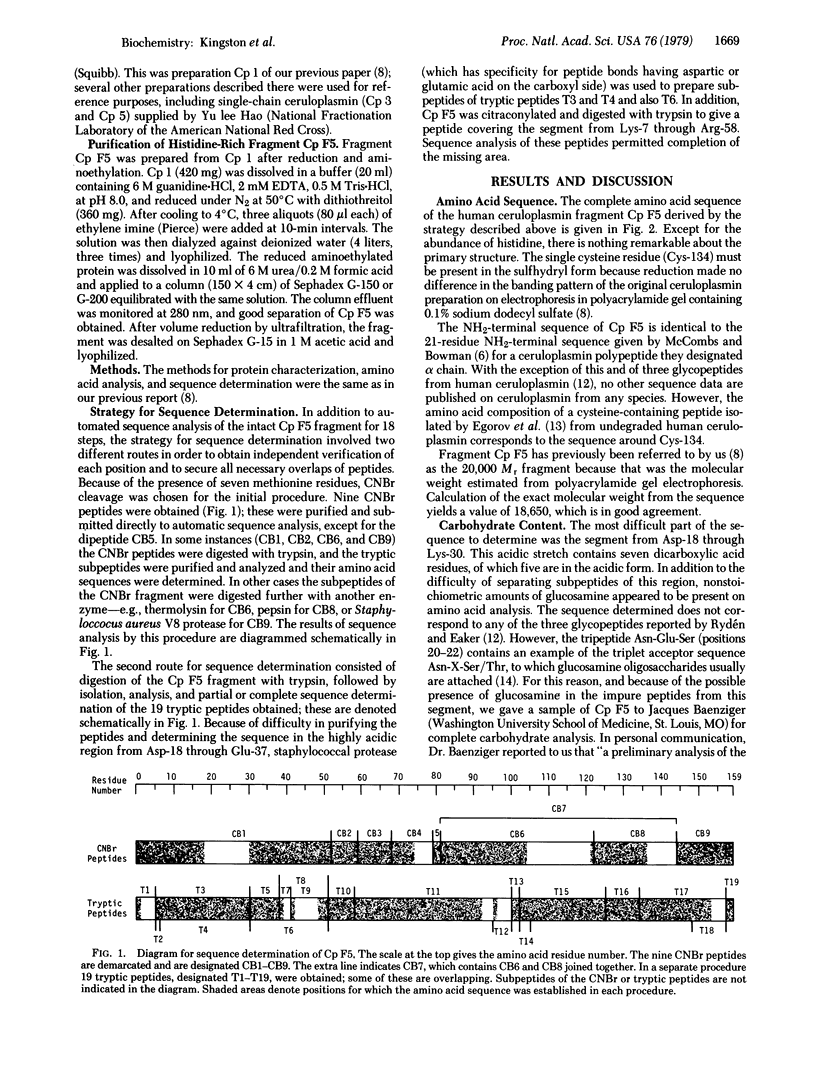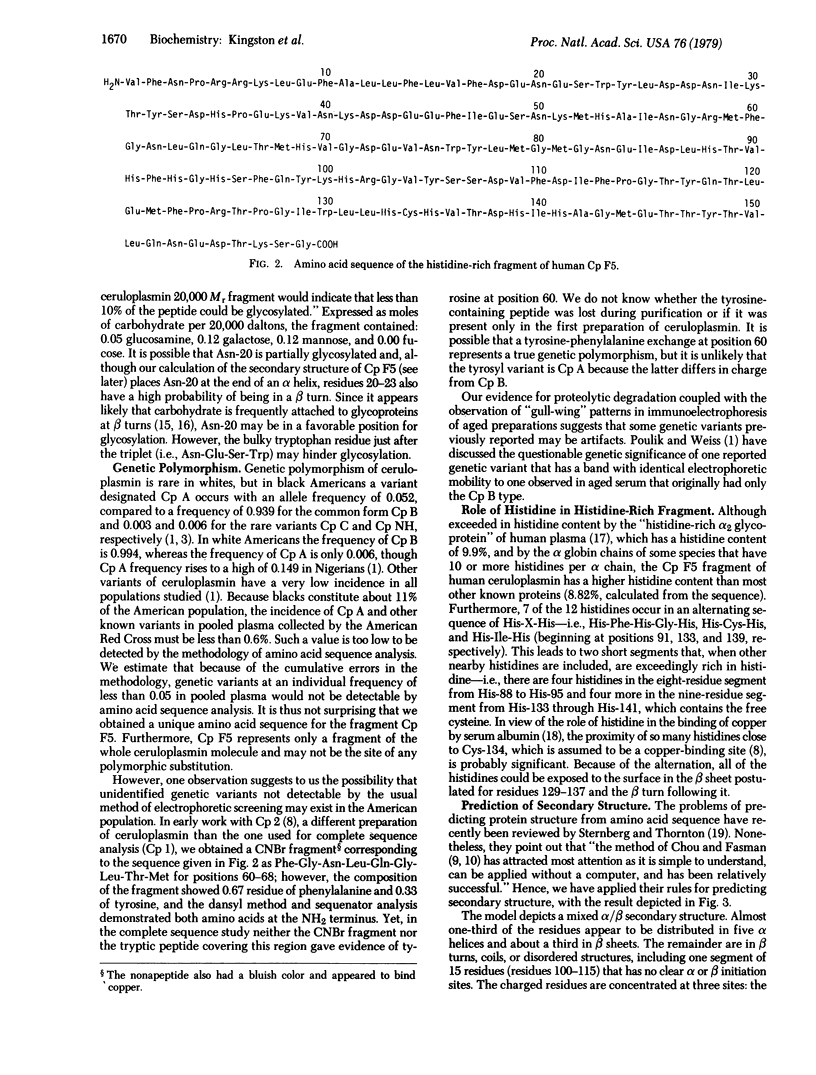Abstract
The complete amino acid sequence has been determined for a fragment of human ceruloplasmin [ferroxidase; iron(II):oxygen oxidoreductase, EC 1.16.3.1]. The fragment (designated Cp F5) contains 159 amino acid residues and has a molecular weight of 18,650; it lacks carbohydrate, is rich in histidine, and contains one free cysteine that may be part of a copper-binding site. This fragment is present in most commercial preparations of ceruloplasmin, probably owing to proteolytic degradation, but can also be obtained by limited cleavage of single-chain ceruloplasmin with plasmin. Cp F5 probably is an intact domain attached to the COOH-terminal end of single-chain ceruloplasmin via a labile interdomain peptide bond. A model of the secondary structure predicted by empirical methods suggests that almost one-third of the amino acid residues are distributed in alpha helices, about a third in beta-sheet structure, and the remainder in beta turns and unidentified structures. Computer analysis of the amino acid sequence has not demonstrated a statistically significant relationship between this ceruloplasmin fragment and any other protein, but there is some evidence for an internal duplication.
Full text
PDF




Selected References
These references are in PubMed. This may not be the complete list of references from this article.
- Adman E. T., Stenkamp R. E., Sieker L. C., Jensen L. H. A crystallographic model for azurin a 3 A resolution. J Mol Biol. 1978 Jul 25;123(1):35–47. doi: 10.1016/0022-2836(78)90375-3. [DOI] [PubMed] [Google Scholar]
- Aubert J. P., Biserte G., Loucheux-Lefebvre M. H. Carbohydrate-peptide linkage in glycoproteins. Arch Biochem Biophys. 1976 Aug;175(2):410–418. doi: 10.1016/0003-9861(76)90528-2. [DOI] [PubMed] [Google Scholar]
- Barker W. C., Ketcham L. K., Dayhoff M. O. A comprehensive examination of protein sequences for evidence of internal gene duplication. J Mol Evol. 1978 Feb 21;10(4):265–281. doi: 10.1007/BF01734217. [DOI] [PubMed] [Google Scholar]
- Chou P. Y., Fasman G. D. Empirical predictions of protein conformation. Annu Rev Biochem. 1978;47:251–276. doi: 10.1146/annurev.bi.47.070178.001343. [DOI] [PubMed] [Google Scholar]
- Chou P. Y., Fasman G. D. Prediction of protein conformation. Biochemistry. 1974 Jan 15;13(2):222–245. doi: 10.1021/bi00699a002. [DOI] [PubMed] [Google Scholar]
- Egorov T. A., Svenson A., Rydén L., Carlsson J. A rapid and specific method for isolation of thiol-containing peptides from large proteins by thiol-disulfide exchange on a solid support. Proc Natl Acad Sci U S A. 1975 Aug;72(8):3029–3033. doi: 10.1073/pnas.72.8.3029. [DOI] [PMC free article] [PubMed] [Google Scholar]
- Freeman S., Daniel E. Dissociation and reconstitution of human ceruloplasmin. Biochemistry. 1973 Nov 6;12(23):4806–4810. doi: 10.1021/bi00747a038. [DOI] [PubMed] [Google Scholar]
- Frieden E., Hsieh H. S. The biological role of ceruloplasmin and its oxidase activity. Adv Exp Med Biol. 1976;74:505–529. doi: 10.1007/978-1-4684-3270-1_43. [DOI] [PubMed] [Google Scholar]
- Heimburger N., Haupt H., Kranz T., Baudner S. Humanserumproteine mit hoher Affinität zu Carboxymethylcellulose. II. Physikalisch-chemische und immunologische Charakterisierung eines histidinreichen 3,8S- 2 -Glykoproteins (CM-Protein I. Hoppe Seylers Z Physiol Chem. 1972 Jul;353(7):1133–1140. [PubMed] [Google Scholar]
- Huber R., Deisenhofer J., Colman P. M., Matsushima M., Palm W. Crystallographic structure studies of an IgG molecule and an Fc fragment. Nature. 1976 Dec 2;264(5585):415–420. doi: 10.1038/264415a0. [DOI] [PubMed] [Google Scholar]
- Kingston I. B., Kingston B. L., Putnam F. W. Chemical evidence that proteolytic cleavage causes the heterogeneity present in human ceruloplasmin preparations. Proc Natl Acad Sci U S A. 1977 Dec;74(12):5377–5381. doi: 10.1073/pnas.74.12.5377. [DOI] [PMC free article] [PubMed] [Google Scholar]
- McCombs M. L., Bowman B. H. Biochemical studies on human ceruloplasmin. Biochim Biophys Acta. 1976 Jun 15;434(2):452–461. doi: 10.1016/0005-2795(76)90235-x. [DOI] [PubMed] [Google Scholar]
- Rydén L., Eaker D. The amino-acid sequences of three tryptic glycopeptides from human ceruloplasmin. Eur J Biochem. 1974 May 2;44(1):171–180. doi: 10.1111/j.1432-1033.1974.tb03470.x. [DOI] [PubMed] [Google Scholar]
- Rydén L. Single-chain structure of human ceruloplasmin. Eur J Biochem. 1972 Apr 11;26(3):380–386. doi: 10.1111/j.1432-1033.1972.tb01777.x. [DOI] [PubMed] [Google Scholar]
- SGOURIS J. T., CORYELL F. C., GALLICK H., STOREY R. W., McCALL K. B., ANDERSON H. D. A large scale method for the preparation and sterilization of ceruloplasmin and apoceruloplasmin from human plasma. Vox Sang. 1962 Jul-Aug;7:394–405. doi: 10.1111/j.1423-0410.1962.tb03272.x. [DOI] [PubMed] [Google Scholar]
- Simons K., Bearn A. G. Isolation and partial characterization of the polypeptide chains in human ceruloplasmin. Biochim Biophys Acta. 1969 Mar;175(2):260–270. doi: 10.1016/0005-2795(69)90004-x. [DOI] [PubMed] [Google Scholar]
- Sternberg M. J., Thornton J. M. Prediction of protein structure from amino acid sequence. Nature. 1978 Jan 5;271(5640):15–20. doi: 10.1038/271015a0. [DOI] [PubMed] [Google Scholar]


